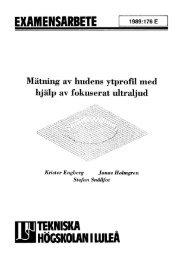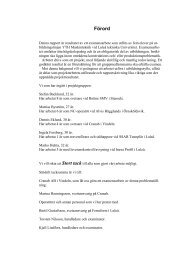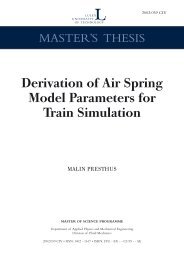LICENTIATE THESIS - Luleå tekniska universitet
LICENTIATE THESIS - Luleå tekniska universitet
LICENTIATE THESIS - Luleå tekniska universitet
You also want an ePaper? Increase the reach of your titles
YUMPU automatically turns print PDFs into web optimized ePapers that Google loves.
Evaluation of Concrete Structures<br />
a) b) c)<br />
Figure 7 Typical cracks for sleepers of class 2 (yellow). a) Sleepers in group 3 i.e.<br />
no visible cracks on the upper side but there might be cracks on the side at the<br />
lower edge. b) Sleepers in group 2 i.e. only 1 or 2 visible cracks on the upper<br />
side. They have fewer cracks on the side towards the lower edge than the sleepers<br />
in group 1 (the crackled pattern is not yet as “developed” as for group 1<br />
sleepers). c) Sleepers in group 1 i.e. cracks in a crackled pattern on the side as<br />
well as on the upper side.<br />
Since the yellow sleepers are so many (about 300 000 up to this date) and the variation<br />
in cracking is so large, they have been divided into subcategories in the hope of finding<br />
out if there is a variation in load carrying capacity among them. The criterion that has<br />
been used as a basis is what kind of cracks an inspector has a chance of discovering<br />
when he/she walks along the railway track. Since the sleepers are covered with<br />
macadam, it is only possible to notice damages that are on the upper side of the sleeper<br />
and 1 to 2 cm along the top parts of the sides. The cracks that have been used as target<br />
have a width larger than 0.05mm. These are possible to see with the naked eye and can<br />
be discovered without the need to get down on one’s knees. These cracks are in this<br />
paper called visible cracks.<br />
The area on the sleeper where the first visible cracks appear (when they lie in the track)<br />
seems to be on the upper side at the end, near the edge. This leads to a problem since<br />
most yellow sleepers also have cracks on the side towards the lower edge, see Figure 7.<br />
These cracks are not possible to detect at an inspection as long as the macadam is not<br />
removed. This might lead to the fact that a yellow sleeper is given the class green.<br />
The subdividing of the yellow sleepers is thus only based on visible cracks on the upper<br />
side of the sleeper, at the end. Worth pointing out is that not all sleepers have two ends<br />
with the same type of damages. Some sleepers have several cracks at one end but no<br />
cracks at the other.<br />
The yellow sleepers have therefore in turn been subdivided into three categories:<br />
Group 1 Several cracks on the upper side with a crackled pattern Figure 7 c).<br />
Group 2 One or two cracks on the upper side, see Figure 7 b).<br />
Group 3 No cracks on the upper side, see Figure 7 a).<br />
3.3 Results<br />
The tests that have been performed are:<br />
(1) Bending capacity of the midsection.<br />
- 13 -







